Ethnicity and Hair Loss: People of different ethnicities have varying hair characteristics. Equally, ethnicity can play a role in the cause and nature of baldness, which in turn influences the best therapeutic approach needed to address it.
Ethnic Hair Loss: Though medicine has developed several hair loss treatments, not every hair restoration technique can treat every hair type. Ancestry plays a role, too, causing treatments and solutions to vary based on ethnicity. Since ethnic hair loss requires special considerations, various backgrounds need different solutions or remedies. For example, people of African American origin might have different needs from people of Asian descent.
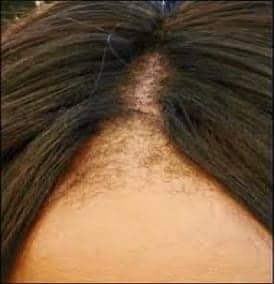
Dermatologists for Ethnic Hair Loss Near Los Angeles:
This patient of African descent experienced hair loss due to a childhood scalp condition that was not due to infection or inflammation. He tried to fill in the missing region with pigmentation but was unhappy with the results. He then decided to choose our clinic to undergo a more specialized hair transplant procedure that would require the safest possible extraction and harvesting of Afro-textured hair follicles. Watch his video below to see his final results.
Dr.UPunch Curl, Best Tool For FUE Hair Transplant for Black Men In Los Angeles
This patient of African-American descent experienced scarring hair loss due to a condition that originated during childhood. The hair loss manifested in the …
Ethnic Hair Loss: The Causes
In general, hair loss results from genetic or hormonal factors. These biological agents also determine the severity of the case. Though the public generally recognizes the genetic components of hair loss, less focus has been placed on the role of environmental factors in the causation of baldness.
Hair Loss and Ethnicity: For example, hair loss among African American women has afflicted the community in increasing numbers in recent years. Certain hairstyles and textured hair account for this increase. African American hair tends to feel coarser, dryer, and curlier, making it more prone to damage and breakage.
Hair Loss Conditions That Are Influenced By Certain Ethnocentric Practices:
While genetics or other biological factors often cause hair loss, some ethnic practices could also contribute to hair loss. Non-biological causes of hair loss can include:
-
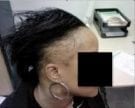
Black hair loss: Traction alopecia causes ethnic hair loss in women due to select hairstyles. It is notorious for causing hair loss in African American women. Photo courtesy of straightfromthea.com - Traction Alopecia – Traction alopecia, the most common cause of hair loss among African Americans, results from the constant pulling on hair follicles. The pulling motion from popular hairstyles such as braids, cornrows, extensions, and weaves often causes African American hair loss around the edges of the hairline. [1]. Balding occurs as a result of the chronic pulling forced on the roots of affected hairs on the edges of the hairlines. Women may gradually see hair loss starting on the front and back of the hairline, temples, and behind the ears. This is by no means limited to women, as African American men also experience hair loss from traction alopecia.
- Central Cicatricial Centrifugal Alopecia – This form of alopecia results from the use of harsh chemicals such as hair relaxers, dyes, and bleaches and harsh grooming practices, including harsh grooming practices hot combs and presses. These harsh hair practices weaken the keratin structure of hair follicles, causing weaker hair and breakage. Damage from this form of alopecia can lead to scarring and permanent hair loss. This form of hair loss most commonly affects middle-aged African American women. Those afflicted with CCCA see hair thinning starting at the mid-scalp, extending outwards in a centrifugal shape. Recently a group of workers has identified a gene variant of PAD13 as a common denominator in patients with CCCA. For the first time, a genetic component has been found to explain the penchant of some individuals for this disease. It is likely that this genetic characteristic results in phenotypes that are predisposed to developing CCCA with the slightest exposure to culprit environmental conditions.
- Folliculitis Induced Alopecia – This hair loss is caused by inflammation and bacterial infection of the scalp and hair follicles. People are suffering from this form of alopecia notice itching and soreness around the scalp resulting from infection. Ethic groups that favor the use of greasy hair pomades and styling gels (such as African American women and Hispanics) would have a higher incidence of this phenomenon. This is because greasy hair products cause the plugging of hair follicle orifices, leading to a build-up of sebum and ultimately folliculitis.
Keloids and Hypertrophic Scarring: A Surgical Peril Of People of Color
People of color have a higher incidence of developing keloids and hypertrophic scarring than the Caucasian population. The incidence of abnormal scarring is highest in people of African extraction, followed by other people of color (Asians, Hispanics, etc.). There is an apparent correlation between the concentration of melanin pigments and scarring activity. For this reason, the tendency to keloids and hypertrophic scarring should be considered in all people of color before surgery is planned. Patients with a clear history of keloids are not good candidates for all surgeries except for essential procedures. Hair transplantation is not an essential procedure and should be avoided in keloidal patients.
African American Hair Loss Treatment: The Solutions
Hair Loss Treatment Ethnic Hair: Treatment of alopecia in African American hair requires both skill and specialization. Fortunately, modern science has developed several African American hair loss treatments. These treatments range anywhere from proper hair care to surgical solutions.
Essential African American Hair Loss Products for Prevention:
- Shampoo – Correct shampooing is one simple, nonsurgical solution that promotes hair growth. Shampooing too often leads to dryness, which causes brittle hair that breaks easily. African American women and people with textured hair should only shampoo their hair every 3-7 days. This longer time between shampooing gives the natural hair oils time to moisturize the scalp. Women who exercise or otherwise sweat should only rinse their hair for proper hygiene. Men and women who avoid Afro hair loss should pay particular attention to shampoo ingredients. A good shampoo should contain little to no alcohol content and sulfates and have a low pH.
- Moisturizing – Properly moisturizing also promotes healthy hair growth. Unlike shampooing, hair requires daily moisturizing. Moisturizers can include oils, leave-in conditioners, and hot oil treatments. Men and women wanting to avoid baldness should never use products with high alcohol content or 2-in-1 shampoo/conditioners. Avoid high heat products, such as dryers, straighteners, and curlers. Minimizing chemical use from products like bleaches, dyes, and relaxers also helps moisturize hair and reduce the chance of African American hair thinning.
More Extreme Black Hair Loss Treatments/Solutions:
- Wigs – Wigs are a temporary solution used to cover up baldness, but relying on wigs has its share of drawbacks. A lack of versatility in weather presents a significant drawback for wig use. Wigs do not adapt well to wind, rain, or water, which often highlights the unnatural nature of the hair.
- Supplements and Remedies – Another nonsurgical solution includes supplements and remedies. The most common natural solutions include Biotin and Ginseng–two herbal supplements believed to promote hair growth. The only proven and FDA-approved hair loss medications are pharmaceutical, over-the-counter drugs, Rogaine, and prescription oral finasteride, which is used only in men. Natural and medicinal supplements both have a similar drawback in that patients need to take both regularly. Discontinuing an herbal or medicinal supplement can result in further hair loss.
- Hair Transplant – Follicular Unit Extraction, or FUE, offers the leading solution to hair loss. However, basic FUE methods struggle with transplanting ethnic hair due to the texture variance. For years, ethnic hair loss remained a problem that FUE methods could not treat. However, thanks to the creation of the Dr.UPunch Curl by Dr. U, patients with tightly curled African type hair now hope to undergo successful FUE hair transplants consistently.
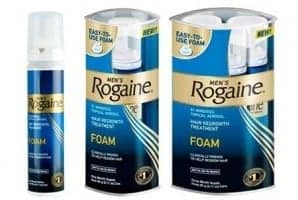
Asian Hair Loss: The Solutions
Though cases of baldness among people of Asian descent have risen in recent years, Asian patients have culturally subscribed to the following remedies on average with higher frequency than other ethnic groups:
- Herbal Remedies – Historically, people in Asia have turned to herbal supplements to combat hair loss. For instance, natural remedies such as Ginseng and green tea have been used by the Chinese for centuries as hair loss remedies. These products’ scientific role in combating hair loss began to manifest only recently.
- Prosthetic Implants – In Japan, doctors still practice prosthetic implants as a solution to specialized hair loss and ethnicity, including the NIDO procedure. Prosthetic implants, however, present a great deal of risk and have a high risk of side effects. Complications can include swelling, infection, or extreme scarring. For this reason, the FDA has banned prosthetic implants in the United States.
- Hair Transplants – Hair transplants, until recently, have had mixed results. Because Asian hair is generally of bigger and more coarse caliber, it leads to the creation of harsh “pluggy” looking hairlines. Dr. U has found a solution to this vexing problem by developing the Dr.UGraft process. The Dr.UGraft is an advanced hair transplant system that enables the extraction of finer nape and body hairs, even in Asians with the coarsest head hairs. This breakthrough means that softer, more natural-looking hairlines can be crafted.
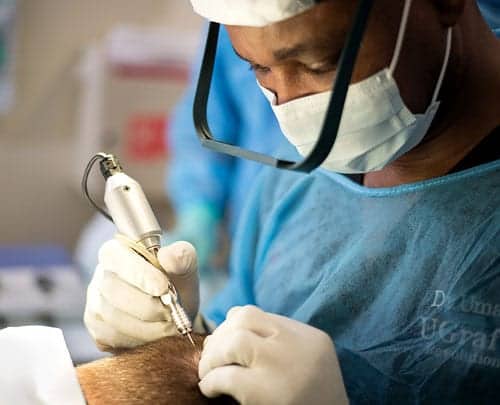
Ethnic Hair Loss Solutions With Dr.UGraft
To overcome the limitations of other FUE methods, Dr. Sanusi Umar created an advanced technique using his specialized Dr.UGraft tool, including Dr.UPunch Rotor and Dr.UPunch Curl. The newer Dr.UGraft Zeus consists of The Intelligent Punch, Nurture handpiece, and uniquely designed Console. The benefits of the Dr.UGraft FUE system in treating ethnic hair loss are multifaceted and include the following:
Better Scarring Profile in Africans and Asians: FUE, in general, does not involve using a scalpel or a heavily invasive process and minimizes the possibility of cosmetically significant scarring. The unique shape of the Dr.UPunch is designed to result in an improved healing profile by encouraging the creation of more minor everted wounds, as everted injuries cause more scarring. The Dr.UGraft system utilizes a flared tip at the end of the punch tool, allowing it to create a less intense wound. This is, of course, an essential consideration for all people of color since they are more prone to scarring problems like hypertrophic scarring.
Crafting Of Softer, More Natural Looking Hairlines and Temple Points In East Asians: As previously mentioned, the thicker caliber of Asian patients often leads to the creation of thicker harsher hairlines and temples, even in the best of hands when using follicular strip surgery methods and essential FUE that rely on head donor hairs only. The Dr.UGraft allows for the use of body hair as donors to the head, helping to create a softer, fuller, and natural-looking hairline.
Universal Success In Harvesting Curly Hair In African Hair: Dr. U’s breakthrough invention of his Dr.UPunch Curl component of the Dr.UGraft has transcended the last frontier of FUE hair transplantation. All existing techniques have been unsuccessful in bringing about universal success in extracting these hair types with dismal rates of 30-40%. With Dr. UGraft’s new addition (Dr. UPunch Curl),100 % of African haired patients can expect that their FUE extraction will occur with significantly lesser transactions than other essential FUE tools. [2]
Dr.UGraft, A Hair Transplant Solution For All Ethnic Groups:
This versatility of the Dr.UGraft method has made it the leading solution for treating ethnic hair loss. The advanced Dr.UGraft system allows hair transplantation from all over the body, not just the head. This expands the donor regions to cover the entire body. This also leads to more natural-looking transplants and hairlines, as Dr. Umar can utilize hair of different types, coarseness, and thickness to reconstruct a full head of hair.
Men and women suffering from ethnic hair loss need not suffer in silence. The invention of the Dr.UGraft FUE system overcomes the limitations of traditional hair transplant surgeries. It also can treat baldness caused by genetics, alopecia, or trauma.
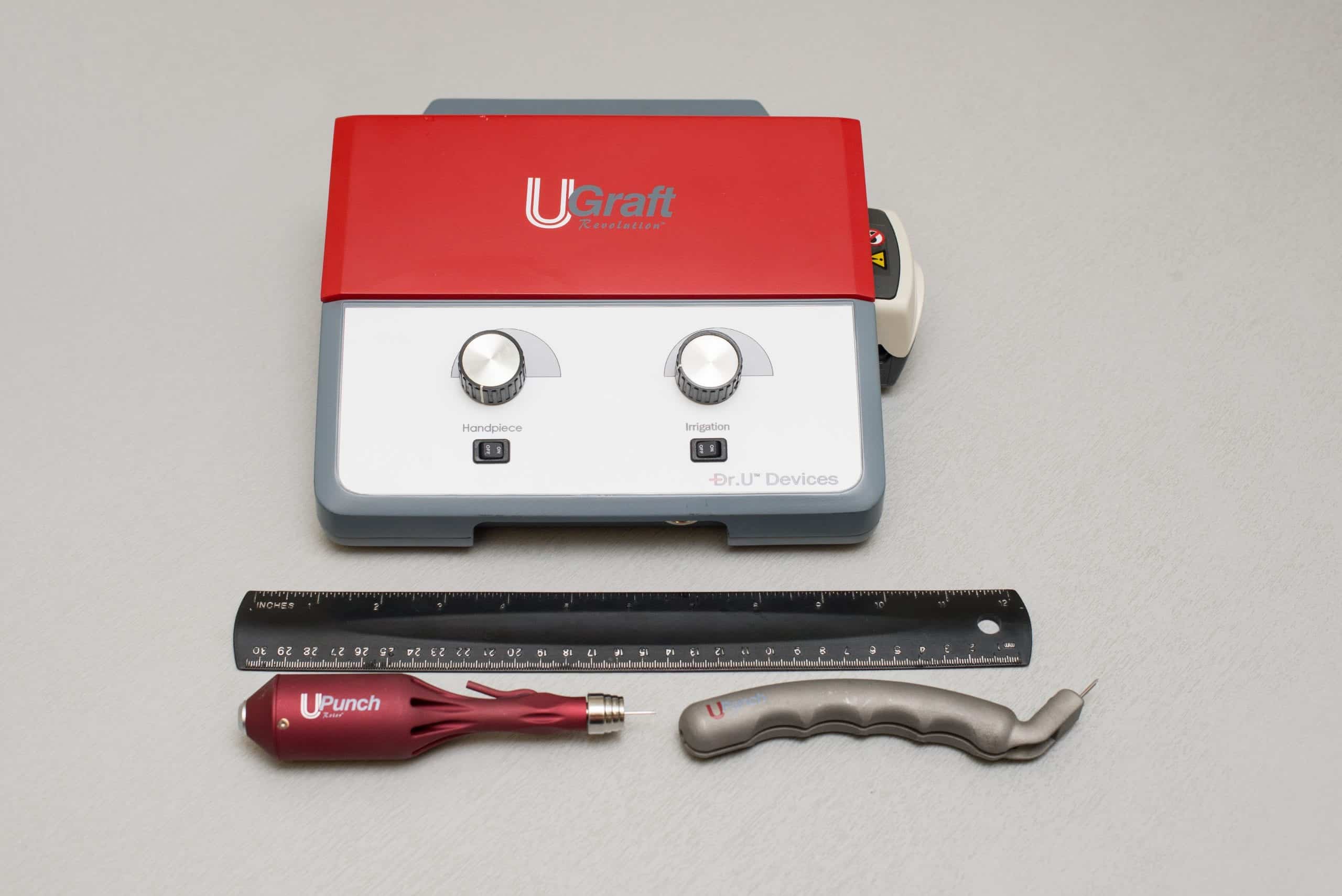

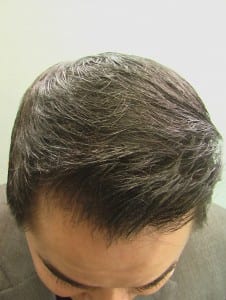
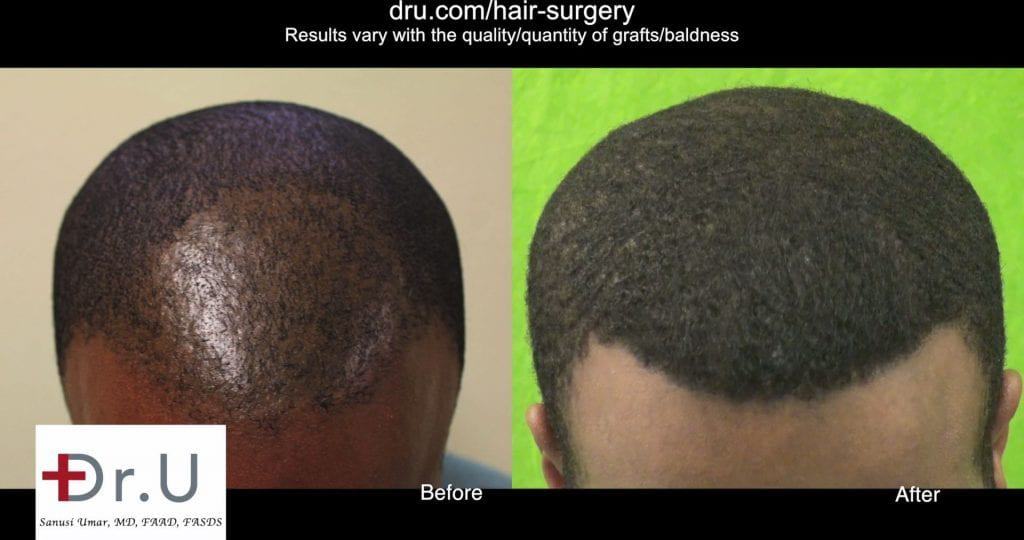
VIDEO: Ethnic Hair Loss Solution In An African Haired Patient Using Dr.UGraft FUE

Is It True That Hair Loss is Less Common in Asians and People of African Descent?
Ethnic hair loss affects all racial groups. People often assume—incorrectly—that men and women of Asian and African descent do not suffer from hair loss:
- ASIANS AND THE MYTH OF IMMUNITY TO HAIR LOSS: Although Asians report balding less than Caucasians or African Americans, hair loss still occurs. Recently the incidence of hair loss in Asians has increased. Doctors still debate the exact cause. Some theorize that a more westernized diet or socioeconomic environment may impact. The mixing of various ethnic groups might also contribute to the increase. Studies show, however, that genetic pattern baldness seems to account for this increase in hair loss among the Asian community.
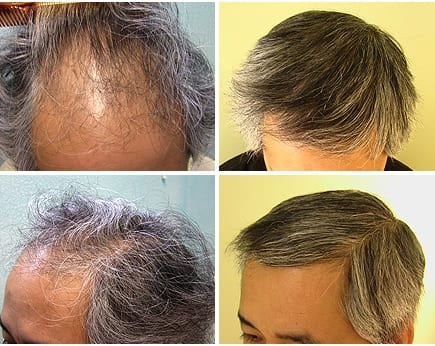
PEOPLE OF AFRICAN DESCENT AND THE MYTH OF IMMUNITY TO HAIR LOSS:
The thinking that Africans suffer hair loss less often has no basis in reality. Instead, it stems from the fact that baldness is often less noticeable in dark-skinned Afro-influenced individuals for two main reasons:
- Afflicted African men tend to favor shaving their heads to hide balding and thinning hair more than other ethnic groups. A shaved head makes the hair loss less noticeable.
- Because of a darker skin tone, the contrast between hairless skin and dark hair is minimized. Coupled with a shaved buzz-cut head, it further makes the detection of hair loss more difficult.
Ethnic Hair Loss and Solutions: Frequently Asked Questions
Other doctors have turned me down for hair transplants in the past. Am I eligible for surgery with Dr.UGraft?
Ethnic hair loss patients ineligible for hair restoration with other FUE or treatment methods can often find a solution with Dr.UGraft. Dr.UGraft includes a particular instrument called the Dr.UPunch Curl tool that allows hair transplant and extraction regardless of shape and texture. This quality makes the Dr.UGraft ideal for treating ethnic hair loss. The ability to transplant hair from other body parts also offers a solution to patients turned down for other FUE methods, as it expands the donor pool beyond the head. The best way to find out for sure is to schedule a consultation with Dr. Umar.
I suffer from Asian female hair loss, possibly due to trauma or traction alopecia. Can Dr.UGraft restore my hairline?
Yes! Because Dr.UGraft can transplant hair from anywhere on the head or body, it offers an ideal solution for Asian female hair loss. Why? Because only through using more delicate nape hairs, which Dr.UGraft specializes in, can the natural softness of the hairline be recreated. Conventional hair transplants that do not use nape hair for this effect would often create a harsh, artificial-looking hairline that would sometimes have a patient wish they had remained bald. Dr. U’s ability to select more delicate hairs from the nape or body, coupled with his talent as a hair transplant artist, enables him to reconstruct the hairline that looks natural, especially in Asian female hair loss scenarios where hairline softness is critical.
I’ve used a hairpiece for years to conceal my hair loss. Should I consider hair restoration with Dr.UGraft?
Yes. As mentioned previously, hairpieces have some severe shortcomings. They often look fake, with discrepancies in hair color or positioning. Even worse, they can come loose or fall off when wet or caught in a breeze. Men and women who use wigs or hairpieces should consider surgery with Dr.UGraft FUE. Hair transplant surgery can rebuild ahead of natural-looking hair that will continue to grow long after the procedure. Silly-looking hairpieces become a thing of the past when replaced by a full head of natural hair.
Dermatologist for ethnic hair loss near Los Angeles, CA: If you have any further questions about hair loss or ethnic hair loss, please feel free to Ask Dr. U more questions using the button below:

References
- SLEPIAN AH. Traction Alopecia. AMA Arch Derm. 1958;78(3):395–398. doi:10.1001/archderm.1958.01560090111025.
- Umar Sanusi. Comparative Study of a Novel Tool for Follicular Unit Extraction for Individuals with Afro-textured Hair Plastic and Reconstructive Surgery 2016; DOI: 10.1093/asj/sjw089. Published September 27, 2016.
